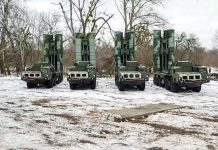An inquiry into the drownings of two US Navy SEALs during a mission to intercept a vessel transporting illegal Iranian-made weapons to Yemen has uncovered significant training deficiencies and misconceptions about how to react after entering deep, turbulent waters.
The incident occurred in January this year, off the coast of Somalia, and claimed the lives of Chief Special Warfare Operator Christopher J. Chambers and Special Warfare Operator 1st Class Nathan Gage Ingram.
Both SEALs, posthumously promoted in rank, were part of an elite team tasked with disrupting the flow of weapons to Iranian-backed Houthi rebels in Yemen.
Chambers, a Division I college champion swimmer, was just days away from his 37th birthday. Ingram, 27, was on his first deployment.
The mission was part of ongoing efforts to curb the Houthis’ missile and drone attacks on commercial and US Navy vessels in the Red Sea and Gulf of Aden, which have intensified since the outbreak of the Israel-Hamas conflict in Gaza a year ago.

The heavily redacted military report, written by an officer outside the Naval Special Warfare Command, concluded that both deaths could have been avoided.
Chambers and Ingram were weighed down by heavy equipment as they attempted to climb aboard the target ship. Their emergency flotation devices proved inadequate against the additional load, leading them to sink rapidly in the rough seas.
Furthermore, the report cited critical breaches in their training, noting “deficiencies, gaps, and inconsistencies” in policies, tactics, and procedures. The SEALs either did not fully understand or disregarded warnings about the limitations of their flotation devices.
The review also highlighted confusion over when and how to deploy emergency flotation and buoyancy devices, which could have helped the SEALs remain afloat. The tragic mishap resulted in both operators being lost at sea as helicopters and drones circled above, unable to save them.

The Naval Special Warfare Command’s findings bring a conclusion to a nine-month investigation aimed at understanding how two highly skilled military operators could drown under such circumstances.
The report underscores the need for training and operational guidance reforms to prevent similar tragedies.
47 Seconds To Disaster
On January 11, a slow-moving dhow, a traditional cargo vessel, was navigating the Arabian Sea off the coast of Somalia. Intelligence suggested the boat was transporting Iranian-made weapons, including ballistic and cruise missile components, intended for Houthi militants in Yemen.
U.S. Submarine Crash: China Answers Why Nuke-Powered USS Connecticut May Have Met An Accident In SCS
The militants had been launching attacks on both commercial and military ships in the region, using the strikes as a form of protest against the ongoing war in Gaza.
In response to this intelligence, a nine-member team, including Navy SEALs Christopher Chambers and Nathan Gage Ingram, was tasked with boarding the vessel under cover of darkness.
Matching THAAD’s Capability, India’s Phase 2 Missile Defense Program Gets CCS Nod For New Test Range
The military plan was to intercept the weapons while the dhow was still in international waters. Two helicopters circling 200 feet above the vessel and drones providing surveillance from the sky supported the mission.
The team departed the USS Lewis B. Puller aboard three specialized speedboats and approached the dhow in rough seas. Upon reaching the vessel, a light tactical ladder, reinforced with grip tape for added stability, was thrown over the ship’s railing.

A team member declared it a “perfect hook,” signaling the team’s readiness to board the smuggling boat. Despite the ladder’s secure attachment, some SEALs chose to climb directly over the dhow’s railing, reporting later that the surface felt slippery, as if freshly painted.
The final two SEALs preparing to board were Chambers and Ingram. Chambers, a former high school state swimming champion who competed for both the University of Massachusetts Amherst and the University of Maryland, decided to bypass the ladder and jump for the railing.
However, he was wearing nearly 48 pounds of gear. As waves began to violently hit the side of the boat, the weight of his equipment quickly overwhelmed him, causing him to lose his grip and fall into the water nine feet below.
Though Chambers resurfaced briefly and managed to grab the ladder, aerial footage reviewed during the investigation showed that he was soon swept away by a powerful wave.
Seeing his comrade in distress, Ingram immediately jumped into the water in an attempt to save him. However, he was carrying around 80 pounds of gear, including a radio rucksack, making it difficult for him to stay afloat. Like Chambers, Ingram quickly sank below the surface.
French Warplanes That ‘Wreaked Havoc’ On British Warships During Falklands War Retired By Argentina
The report noted that Ingram’s helmet barely broke the water’s surface, suggesting he had deployed a special flotation device in a desperate attempt to stay afloat. At one point, he appeared to try shedding some of his gear, but his flotation device was later found intact and drifting in the ocean.
The Navy’s investigation concluded that the weight of their gear, coupled with the insufficient performance of their flotation devices, meant that neither SEAL had a chance of staying above water. Both men were tragically lost to the sea within 47 seconds.
US Navy SEALs
Intercepting and boarding vessels at night is among the most perilous missions undertaken by Navy special operators, demanding a unique skill set and extensive training.
The tragic incident in January that resulted in the loss of the two Navy SEALs does not cast doubt on their capabilities; these highly trained soldiers represent the pinnacle of the US military elite.
Life as a Navy SEAL is anything but predictable. Enlisting in this demanding role means embracing a lifestyle filled with ever-changing circumstances and challenges.
However, the path to becoming a SEAL is not open to everyone. Each year, around 1,000 candidates begin the Navy SEAL training program, yet only about 200 to 250 complete it.
With nine active-duty SEAL Teams stationed at over 30 locations worldwide, only the most exceptional individuals are accepted. The Navy SEAL selection process is rigorous, and even elite athletes, including Olympic contenders, have faced failure.

Physical stamina is crucial, but it is not the only requirement for aspiring SEALs. The training program lasts a minimum of 18 months from boot camp until joining a SEAL team, with continuous training throughout their careers.
The journey begins with preliminary assessments, including a medical screening and tests like the Armed Services Vocational Aptitude Battery (ASVAB) and the Computerized-Special Operations Resilience Test (C-SORT).
The Physical Screening Test (PST) is particularly demanding, with different requirements for enlisted and officer candidates. Enlisted SEALs must swim 500 yards in under 9 minutes and 30 seconds, complete 75 push-ups, and run 1.5 miles in 9:30, among other benchmarks, while officer candidates face even higher standards.
Navy SEAL training is divided into several stages, starting with the Naval Special Warfare Preparatory School (NSW Prep), which focuses on physical readiness for Basic Underwater Demolition/SEAL School (BUD/S). This two-month phase emphasizes fitness, academics, and mental fortitude.
The next stage, Naval Special Warfare Orientation (NSWO), lasts three weeks and introduces candidates to the BUD/S lifestyle, highlighting teamwork and perseverance. Instructors begin identifying candidates who display exceptional skills during this phase.
The first phase of BUD/S, often referred to as “Hell Week,” spans seven weeks and tests candidates’ physical limits, mental resilience, and teamwork abilities. With events timed to assess performance, many candidates choose to leave due to the demanding nature of the training.
Hell Week is grueling. Over five days, participants receive only about four hours of sleep while engaging in continuous physical exertion.
Following Hell Week, candidates focus on combat diving, where they learn essential underwater skills in stressful conditions. The third phase includes land warfare training, covering marksmanship, navigation, and combat tactics, along with classroom knowledge to prepare for real missions.
The final stage, SEAL Qualification Training (SQT), spans 26 weeks and encompasses advanced tactical training. Upon completion, candidates earn their SEAL Trident and are assigned to a SEAL team, where they undergo further training for major deployments.
This extensive preparation ensures every SEAL is equipped to face the challenges ahead, highlighting the perseverance and unwavering dedication required to serve and protect.
- Contact the author at ashishmichel(at)gmail.com
- Follow EurAsian Times on Google News




